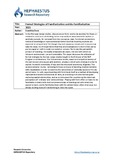| dc.description.abstract | In the first-year design studios, discussions on form tend to be avoided; for those un-initiated in architectural thinking, forms may easily be associated with stylistic or aesthetic pursuits, far removed from the conceptual rigor, functional connections, technical knowledge or representational dexterities that incoming students are expected to comprehend. Yet though idea and sequence, visuals and structure may take the stage, it is through forms that they are investigated; it is forms that can be put on paper or built in models or coded on screens. Forms are the perceptible product of teaching, the readily analyzable lab object, the tool with which we interpret environment, use and materiality. This paper discusses the utilization of formal strategies by the two design studios taught in the first year of the NUP Program in Architecture. The first-semester studio, based on a simplified version of the well-known nine-square grid problem, employs a kit-of parts strategy in order to exploit the tactile materiality of toys and the structural consistency of games. The second-semester studio, narrowing its focus on issues of dwelling, meshes narrative with visualization in order to examine the conventions of everyday spaces in the city and at home. In both, experimenting with form lends itself as a method of developing representational and communication skills, as a technique of understanding and exploring spatial relationships, and as an instrument for questioning the dominant perceptions of ‘ordinary’ and ‘extra-ordinary’. Playing with form offers a means to de-familiarize students with their accustomed ways of learning and with what they expect to learn, and to familiarize them with the seldom linear, often strenuous, but always exciting route of transforming an idea into space. | en_UK |


